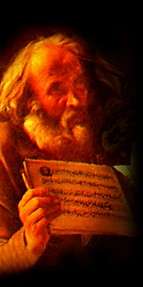 |
 |
 |
 |
 |
|
I have discovered that it is enough when a single note is beautifully played. This one note, or a silent beat, or a moment of silence, comforts me. I work with very few elements--with one voice, with two voices, I build with the most primitive materials--with the triad, with one specific tonality. The three notes of a triad are like bells. And that is why I call it "tintinnabulation."
Arvo Pärt
|
| EARLY PERIOD (1959-68) |  |
|
| His most prominent works from this period are the cantata Meie aed (Our Garden) for three-part children's choir and orchestra and his oratorio Maailma samm (Stride of the World) for chorus and orchestra. |
| MIDDLE PERIOD (1968-76) |  |
|
Demonstrated a high degree of experimentation with techniques including polytonality, indeterminacy, collage, pointillism, and pastiche
Applies canonic serial writing not only to pitches, but also to rhythms, as in his instrumental piece, Perpetuum mobile
Acknowledges the influence of Western theorists and composers such as Ernst Krenek and John Cage
His use of avant-garde techniques is confined mostly to instrumental genres
His most prominent choral work of this period is Credo for Piano, Mixed Chorus, and Orchestra. A portion of this work is built on a tone row, but the row is not used in a strictly serial manner. He employs choral whispering and unconventional notation. He further uses early music devices such as long, cantus firmus-like notes and builds this piece around J.S. Bach's C-Major Prelude from Book I of Das wohltemperierte Clavier.
|
| THIRD PERIOD (1976-Present) |  |
|
His early music interest has continually increased during this period. He studies Gregorian chant, Notre Dame organum, and the music of Obrecht, Ockeghem, and Josquin. He once said of chant, "Gregorian chant has taught me what a cosmic secret is hidden in the art of combining two or three notes."
Emerged with a new style called tintinnabuli- this term refers to the ringing of bells, music in which the sound materials are in constant flux, though the overall image is one of stasis, or constant recognition. By means of almost purely tonal structure, frequently broken triads and scales, Pärt creates an inner balance of form and harmony which can be understood in terms of his deep religious faith and inclination to mysticism.
The four organ pieces, which he has written in 1976, 1980, 1987, and 1988, respectively, employ tintinnabuli. It is especially prominent in Annum per annum and Mein Weg hat Gipfel und Wellentaler.
|
| Other Style Characteristics |  |
|
 traditional, neo-Baroque idiom, strict to form, freely dissonant in harmony; under the influence of Western musical modernism (early works- early to mid-'60's)
traditional, neo-Baroque idiom, strict to form, freely dissonant in harmony; under the influence of Western musical modernism (early works- early to mid-'60's)
influenced by Prokofiev and Shostakovich (early works)
experimented with polytonality, serialism, pointillism, aleatory, collage, minimalism, and a Satie-like simplicity
was first Estonian composer to use Schoenberg's 12-tone method (as in his First Symphony-1960, and in Nekrolog [dedicated to the victims of the Holocaust] - 1963)
revived old polyphonic forms and past harmonies from medieval music together with ideas from Gregorian chant (as in his Third Symphony in 1971)
Although he initially composed in traditional manner, in terms of writing instrumental pieces in a neo-Baroque idiom which was to strict to form and freely dissonant in harmony, he gradually levitated toward empiric sonorism under the influence of Western musical modernism, without renouncing the historic foundation of tonality.
one of his specialties is called tintinnabula, in which he applies shifting phrases of a given chord
extending the concept of integral dodecaphony, he makes use of pandiatonic and panpentatonic tone-clusters, culminating in the formation of a blob of white noise
by Trey Clegg
|
|
|
|

